Titan Timeline: Experts on implosion to last transcripts, recapping the tragedy
Less than three weeks ago, the Titan Submersible by OceanGate Expeditions suffered a catastrophic implosion that resulted in the instant deaths of its five passengers. Aboard the tourist craft were OceanGate CEO Stockton Rush, 61; British billionaire Hamish Harding, 58; renowned Titanic expert, Paul-Henri Nargeolet, 77; prominent Pakistani businessman Shahzada Dawood, 48, and his 19-year-old son, Sulaiman Dawood.

The submersible went missing on June 18, 2023. When it entered the water, it had about 96 hours of oxygen which was expected to run out on June 22, 2023. The surface vessel, Polar Prince lost contact with the submersible approximately one hour and 45 minutes after it commenced its dive to the site of the Titanic's wreckage.
Titan Tragedy Timeline: Search and Rescue
The United States Coast Guard, United States Navy, and Canadian Coast Guard led the search and rescue efforts with the support of multiple governments. On June 20, 2023, sonar picked up “banging” sounds from underneath the water. The noise was detected at 30-minute intervals. Reports suggest that the banging was being heard even after four hours following the deployment of additional sonar devices. More sounds were later heard, but they were not described as “banging.”
Also Read | What were the banging sounds heard during search for Titan sub? Experts weigh in
On June 22, 2023, the US Coast Guard announced the discovery of a significant debris field within the designated search area. The missing submersible's landing frame and rear cover had been found.“They don't use phrases like 'debris field' unless there's no chance of a recovery of the men alive. A debris field implies a break-up of the submersible ... that really sort of indicates what is the worst-case scenario, which is a catastrophic failure and generally that's an implosion,” said rescue expert David Mearns.
Later that same day, the US Coast Guard said that all five people aboard a submersible died – likely in an instant – when their vessel suffered a "catastrophic implosion" in the ocean depths. And with this sombre announcement ended the multinational search-and-rescue operation.
It is believed that the submersible imploded so fast that all five victims onboard would have been unaware of the event taking place.
Also Read | Titan submersible incident: Can the dead bodies of five onboard be recovered?
Ofer Ketter, a longtime submersible specialist and co-founder of private sub company Sub-Merge told New York Post that the force of the implosion which caused Titan to collapse inward in milliseconds under the massive pressure of the sea, might have turned parts of the vessel "to dust".
According to Roderick Smith, an engineering professor at Imperial College London, the probable cause of the accident can be attributed to a "failure of the pressure hull."
Rear Admiral John Mauger confirmed that the discovered debris indicated a "catastrophic implosion." The extreme pressure at a depth of 13,000 feet likely caused the sub to collapse inward, resulting in an instantaneous and ‘painless’ end for the passengers.
Also Read | Viral videos: How Titan submersible implosion would have looked like
Last Communication with the Titan Submersible
On July 6, 2023, screenshots claiming to be the final communications of the submersible were shared. According to these, when the descent reached the 75-minute mark, the passengers expressed their confidence, stating that everything is under control.
However, at 9:28 am, the crew aboard the Titan notices an alarm from the Real-Time Monitoring System, prompting unanimous agreement to abandon the descent and begin ascending. Unfortunately, the ascent proves slower than anticipated.
By the time they provide their final update, the Real-Time Monitoring System displays "all red" alerts. At 9:50 am, the ship, the Polar Prince, attempts to establish communication with the sub, stating, "We're not receiving you. Update please."
The transcript abruptly concludes at 9:57 am, with a final plea from the ship urging the sub to respond if able.
Although no official word confirms the veracity of this transcript experts, including 'Titanic' director James Cameron, find its content plausible.
Also Read | Are Titan's last communication images going viral real? Netizens speculate veracity as details emerge
Description of the Submersible
OceanGate explained that the Titan is a 23,000-pound submersible made of carbon fibre and titanium. The vessel uses a “proprietary real-time hull health monitoring (RTM) system,” and any time an issue is detected, an “early warning” would be sent to the pilot, to leave “enough time to … safely return to the surface.”
With a nine feet wide and 8 feet tall structure, Titan left little room for its crew. Passengers were cramped in on a subfloor inside the carbon-fibre tube. With only one toilet and no seats, passengers had to sit cross-legged on the floor. There were no windows except the porthole through which passengers could view the Titanic.
Also Read | Inside the lost Titanic submersible: No seats, one toilet and no windows
Previous Safety Concerns Ignored
Following this tragedy, harrowing details emerged about the reckless behaviour and disregard for safety exhibited by OceanGate CEO Stockton Rush. A video interview from 2021 revealed Rush's audacious mindset where he expressed a desire to be remembered as an innovator and boasted about breaking rules. He quoted General Douglas MacArthur's statement that "You're remembered for the rules you break." Rush said safety is “pure waste.”
“I mean if you just want to be safe, don’t get out of bed, don’t get in your car, don’t do anything,” Rush said in a 2022 podcast with CBS reporter David Pogue. “At some point, you’re going to take some risk, and it really is a risk-reward question.”.
But the late CEO believed that selectively breaking rules could bring value to society and innovation. He also admitted the difficulty in testing and understanding the behaviour of carbon fibre under extreme pressure, emphasizing the need for further research.
It has been revealed that Rush was warned about the risks he was taking. A former OceanGate Expeditions employee had reportedly warned of “quality control and safety” problems related to the Titan submersible back in 2018. David Lochridge, OceanGate’s former director of marine operations, had raised concerns about how the vessel was handled by the company. As per a lawsuit, David was wrongfully terminated after he said he found a “lack of non-destructive testing performed on the hull of the Titan.”
While the cause of the implosion of Titan submersible is yet to be ascertained officially Ed Cassano, CEO of Pelagic Research Services which led Titan's search-and-rescue operation, said that the submersible was “pushed beyond its depth rate.”
Experts including industry leaders, oceanographers and deep-sea explorers had also warned about OceanGate's ‘experimental’ approach that could lead to a ‘catastrophic’ issue with the expedition project. Prominent figures, including billionaire investor Ray Dalio, expressed their anger and accused Rush of displaying reckless behaviour by neglecting tried-and-true safety measures.
According to the email obtained by the BBC, deepsea submersible expert Rob McCallum pleaded with Rush to delay using the Titan until it was thoroughly tested and independently classified. Rush's response, however, was dismissive, accusing industry players of using safety arguments to hinder innovation.
Production of the Submersible
Questions have arisen about the use of off-the-shelf components and a lack of rigorous testing of the Titan submersible. In an interview, Stockton Rush boasted that the submersible was operated through a video game controller.
Also Read | Stockton Rush allegedly hired INTERNS to design Titan sub's electrical systems
In March 2018, the Marine Technology Society, a group of ocean technologists and engineers, sent a letter to OceanGate asking the company to adopt recognized safety standards for the Titan, saying the company’s “‘experimental’ approach” could result in “negative outcomes (from minor to catastrophic).”
Also Read | Titanic tour leader Stockton Rush loved taking risks, called safety a ‘pure waste’
Then in a 2020 release posted on the company’s website, OceanGate said that “NASA’s Marshall Space Flight Center in Huntsville, Alabama, will serve as the facility where the development and manufacturing of a new aerospace-grade hull is completed” for its latest submersible. In a statement Wednesday, NASA said it consulted on the materials and construction process for the Titan but didn’t conduct testing or use its workforce or facilities for manufacturing.
Recently it was revealed that Rush had boasted that his company can monitor any issue with its Titan submersible’s carbon fibre hull. He praised the vessel’s technology as "one of the great moments of submersibles." He said the glue holding the Titan submersible’s carbon-fibre hull together was "like peanut butter,” adding that it was thicker than Elmer's glue. He also described it as being “pretty simple”, saying that the design was "pretty simple, but if we mess it up, there's not a lot of room for recovery."
Previous Passengers’ Report
Harrowing revelations claim that OceanGate’s Titan submersible once had a battery die during a dive to the Titanic wreckage. Jaden Pan opened up about his voyage in a 2022 episode of the BBC's ‘The Travel Show.’ He took the Titan submersible to the Titanic wreck in 2021, and later revealed that his expedition was disturbed when a battery "went kaput."
In that situation, the company’s CEO, Stockton Rush, allegedly suggested that the crew sleep in the vessel, as per a BBC documentary. "At first, I thought he was joking because we were over two hours into our expedition and so close to the bottom," Jaden said. "But then he explained that one of the batteries went kaput and we were having trouble using the electronic drops for the weights, so it would be hard for us to get back up to the surface."
Stockton allegedly suggested that they sleep as the submersible sank to the ocean floor. "We're down here for another 16 to 24 hours," Stockton said on the show. "We will drift down. We'll hit the bottom. We'll have communications. We can talk to them."
Also Read | Ex-passenger says Stockton Rush told crew to sleep when Titan's battery died
Reports also revealed that Rush once said that the doomed Titan submersible was struck by lightning, getting severely damaged in the process. The incident took place during a test dive in the Bahamas in 2018.
"Fortunately, it was not a direct strike. A direct strike to the carbon fibre probably would have taken us totally out," Stockton said in the interview. According to an OceanGate post, the vessel had "sustained lightning damage that affected over 70% of its internal systems."
"Fortunately, we are using commercial off-the-shelf and line-replaceable items. So in a matter of a couple of days, we were able to replace all those components," Stockton said. The company, however, aborted the test dive due to the lightning strike.
OceanGate’s Credibility in Question
Las Vegas financier Jay Bloom, who was approached by Rush to be a part of his Titanic trip, claims Rush was not interested in tourism whereas he just wanted to fund his obsession with the Titanic. In an interview with The Post, he said, “Rush wasn’t really looking to build a tourism business to the Titanic.”
“He wanted to research and document the decay of the ship over time.' A big red flag for Bloom was that there was no training required to step into the vessel, 'Just climb through the hatch and get in,” Bloom stated.
The recent exposure of Rush's irresponsible conduct and complete disregard for safety protocols has tarnished OceanGate's reputation and sparked doubts about its dedication to the safety of its staff and travellers.
The Titanic sub catastrophe has raised legal and ethical questions about the responsibility of OceanGate and its operators. The failure to ensure adequate safety measures and potential misrepresentations regarding the submersible's design may have legal consequences. Furthermore, the ethical implications of offering high-priced expeditions without stringent regulations are under scrutiny.
Disclaimer: The copyright of this article belongs to the original author. Reposting this article is solely for the purpose of information dissemination and does not constitute any investment advice. If there is any infringement, please contact us immediately. We will make corrections or deletions as necessary. Thank you.
Title:Titan Timeline: Experts on implosion to last transcripts, recapping the tragedy
Url:https://www.investsfocus.com









